HIST2380 History of Japan
Semester 2 (2022-2023)
Lecture TimeThursday, 10:30 - 12:15
VenueRoom 302, Lee Shau Kee Building (LSK 302)
LanguageCantonese
Lecturer SIU Kam Wah (kamwsiu@cuhk.edu.hk)
Teaching Assistant ZHAO Xiaoxi (1155087650@link.cuhk.edu.hk)
This course explores the history and culture of Japan from the ancient time to the present. It covers the aspects of political and economic development, foreign relations, social thought, cultural feature, historical site and various typical literature of Japan in different periods. Through this course, students will gain a thorough understanding of the cultural evolution of Japan which was greatly influenced by the cultures of China, Europe and the U.S. successively, and the interactions among the developments of politics, society and literature in Japan. They will also be able to command the prospect of Japan, the Japanese culture and Sino-Japanese relations in the 21st century. This course is interactive in nature. Lessons will be conducted in the forms of PowerPoint demonstration, multi-media learning (watching history film, documentary, TV program, drama, song and dance, music program and the Internet entertainment, etc), appreciation of photos of historical site and relic, selective reading of the traditional and pop literature, class discussion, interactive tutorial and e-learning modules.
References Used in the Course

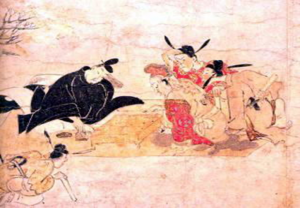
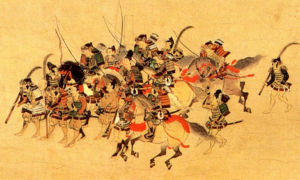
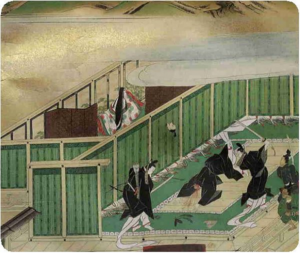
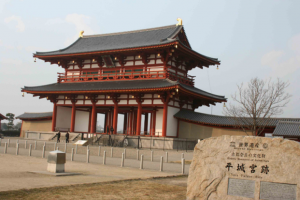



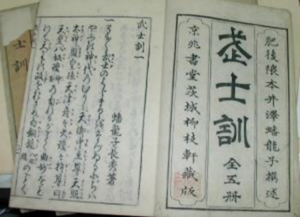

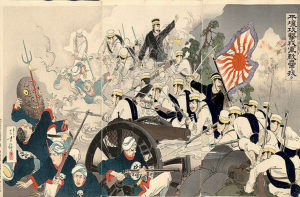
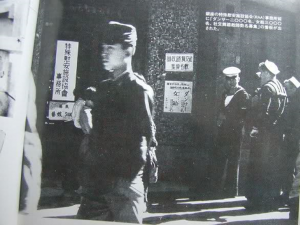
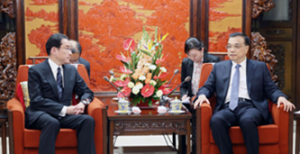
- 先史時代 (ca30000 BC – ca AD 300) (12 Jan)
日本文化源流:舊石器文化與縄文文化;彌生文化;邪馬台國文化與日本國家誕生等
- 原史時代 (300-710) (19 Jan)
古墳文化與日本神話;朝鮮、中國關係及中國大陸文化傳入;聖德太子改革;飛鳥文化;大化革新;律令制與氏族制等
- 古代 (710-1185) I: 奈良時代 (710-794) (2 Feb)
平城京;天皇統治;遣唐使與渡日高僧;佛教傳入與發展;白鳳文化;天平文化等
- 古代 (710-1185) II: 平安時代 (794-1185) (9 Feb)
平安京遷都;攝關政治與莊園制形成;武士團興起;唐宋兩朝友好外交關係;變革的平安文化;平安佛教等
- 中世 (1185-1573) I: 鎌倉時代 (1185-1333) (16 Feb)
鎌倉幕府;律令制衰落;武士政權鞏固;宋元兩朝貿易;訪中高僧;鎌倉佛教與神道;鎌倉文化等
- 中世 (1185-1573) II: 室町前期 (1333-1477) (23 Feb)
農業發展、商業化及市鎮化;蒙古來襲與鐮倉幕府崩潰;南北朝亂局與室町幕府;明朝經濟文化交流;室町前期文化;室町前期宗教融合與創新等
- 中世 (1185-1568) III: 室町後期 (1477-1568) (2 Mar)
室町幕府衰落;惣的發展與一向一揆的興衰;戰國大名領國制;室町後期群眾化文化;國民宗教形成;葡萄牙貿易;自由城市興起;天主教傳播等
- 近世 (1568-1867) I: 德川前期 (1603-1680) (16 Mar)
織豐政權;安土、桃山文化;德川幕府建立與集權統治;經濟增長與京都復興;朱子學、史學及武士道;中國朱印船、荷蘭之貿易;鎮壓法華宗「不受不施派」與禁制天主教;鎖國等
- 近世 (1568-1867) II (23 Mar)
德川中期 (1680-1716):幕藩體制及財政危機;城下町發展與町人生活思想;元祿平民文化;日本文藝復興論等;
德川後期 (1716-1867):經濟停滯衰退;享保改革;幕藩制動揺與寛政改革;國學形成;蘭學及諸文化等;攘夷與開國;尊皇攘夷運動與倒幕等
- 近代 (1868-1945) I (30 Mar)
近代國家的成立:外來壓力;明治維新;自由民權運動與政黨;近代天皇制與帝國建立;工業化與資本主義;
軍國主義形成:甲午戰爭;日俄戰爭;一次大戦;明治大正時代社會與文化等
- 近代 (1868-1945) II (6 Apr)
奪糧暴動與一戰後經濟恐慌;初期國會、普選運動及政黨内閣制;紊亂外交;帝國主義危機;從侵華到太平洋戰爭;兩戰間之日本文化等
- 現代 (1945至今) I: 企業日本的政經、外交及社會發展 (1945-1990) (13 Apr)
美國軍事佔領及日本戰後改革;美國佔領政策轉變;《舊金山和約》;戰後政黨政治形成;經濟復甦與高度經濟成長;貨幣、石油危機;經濟大國之途;外交政策;步向政治大國;新人類世代等
- 現代 (1945至今) II: 戰後至今日本文化與當前中日關係 (20 Apr)
戰後日本文化發展;戰後至今兩性關係;企業日本大眾傳媒與文化表述;1990年代至今大眾文化;21世紀的中日關係等
- Term Paper 60%
- Tutorial Presentation & Comment 30%
- Blackboard Multiple Choice Test 10%
評分使用之成績等級描述 (Grade Descriptors)
Grade A
Outstanding performance on all learning outcomes.
Grade A-
Generally outstanding performance on all (or almost all) learning outcomes.
Grade B
Substantial performance on all learning outcomes, OR high performance on some learning outcomes which compensates for less satisfactory performance on others, resulting in overall substantial performance.
Grade C
Satisfactory performance on the majority of learning outcomes, possibly with a few weaknesses.
Grade D
Barely satisfactory performance on a number of learning outcomes.
Grade F
Unsatisfactory performance on a number of learning outcomes, OR failure to meet specified assessment requirements.
13 Tutorials
老師主持所有13次導修課。每次的兩節導修課在講授課堂前後舉行。
第1節導修課時間與地點:
星期四 9:30am-10:15am 李兆基樓LSK 302室
第2節導修課時間與地點:
星期四 12:30pm-1:15pm 李兆基樓LSK 302室
參與第1節導修課的組別同學:A1組,A2組,B1組,B2組
參與第2節導修課的組別同學:C1組,C2組,D1組,D2組
全體同學自由參與第1-4次的兩節導修課
導修1:「課程暨講授課內容、擬定學期論文題目諮詢」導修 (12 Jan)
導修2:「擬定學期論文題目諮詢」導修 (19 Jan)
導修3:「擬定學期論文題目諮詢」導修 (2 Feb)
導修4:「擬定學期論文題目諮詢」導修 (9 Feb)
各組同學按照以下安排參與第5-12次導修課
同學報告學期論文大綱之要求 (Term Paper Outline Presentation Requirement)
同學須在導修課前三日向老師電郵提交約700字學期論文大綱報告,簡介學期論文題目、內容大綱及初步參考書目(包括相關原始史料及近人著作),老師給予意見。
導修5:第1節導修課:A1組同學報告學期論文大綱;第2節導修課:C1組同學報告學期論文大綱 (16 Feb)
導修6:第1節導修課:A2組同學報告學期論文大綱;第2節導修課:C2組同學報告學期論文大綱 (23 Feb)
導修7:第1節導修課:B1組同學報告學期論文大綱;第2節導修課:D1組同學報告學期論文大綱 (2 Mar)
導修8:第1節導修課:B2組同學報告學期論文大綱;第2節導修課:D2組同學報告學期論文大綱 (16 Mar)
同學報告學期論文初稿(/未完稿)與專責評論同學評論之要求 (Term Paper Presentation & Comment Requirement)
同學須在導修課前三日向老師和專責評論同學電郵提交學期論文初稿/未完稿,然後在導修課堂上報告論文要點,由專責評論同學評論,再由老師給予意見。
導修9:第1節導修課:A1組同學報告學期論文初稿(/未完稿),B1組同學給A1組同學報告論文作口頭評論;第2節導修課:C1組同學報告學期論文初稿(/未完稿),D1組同學給C1組同學報告論文作口頭評論 (23 Mar)
導修10:第1節導修課:A2組同學報告學期論文初稿(/未完稿),B2組同學給A2組同學報告論文作口頭評論;第2節導修課:C2組同學報告學期論文初稿(/未完稿),D2組同學給C2組同學報告論文作口頭評論 (30 Mar)
導修11:第1節導修課:B1組同學報告學期論文初稿(/未完稿),A1組同學給B1組同學報告論文作口頭評論;第2節導修課:D1組同學報告學期論文初稿(/未完稿),C1組同學給D1組同學報告論文作口頭評論 (6 Apr)
導修12:第1節導修課:B2組同學報告學期論文初稿(/未完稿),A2組同學給B2組同學報告論文作口頭評論;第2節導修課:D2組同學報告學期論文初稿(/未完稿),C2組同學給D2組同學報告論文作口頭評論 (13 Apr)
導修13:第1、2節導修課 學期論文諮詢 全體同學自由參與 (20 Apr)
General References
日本史史料
- 東京帝國大學文學部史料編纂掛編纂:《大日本史料》。東京:東京帝國大學, 1901-。
- 下中彌三郎編:《日本史料集成》。東京:平凡社,1956。
- 史學會編:《史料日本史》兩冊。東京:山川出版社,1961。
- 大久保利謙等監修:《史料による日本の步み》四冊。東京:吉川弘文館,1955-1960。
- 谷川健一等編:《日本庶民生活史料集成》三二冊。東京:三一書房,1968-1983。
- 豬木正道編:《日本政治外交史資料選》。東京:有信堂,1967。
- 小野武夫編著:《日本農民史料聚粹》。東京:酒井書店,1970-。
- 靑木惠一郎編、解題:《日本農民運動史料集成》東京:三一書房,1976-1977。
- 太田博太郎編集:《日本建築史基礎資料集成》。東京:中央公論美術出版,1971-。
- 大庭修編著:《唐船進港回棹錄・島原本唐人風說書・剖符留帳》。吹田市:關西大學東西學術硏究所,1974。
- 菅原憲二編:《記錄史料と日本近世社會》。千葉市:千葉大學大學院社會文化科學研究科,2000。
- 大庭修編著:《享保時代の日中關係資料》。吹田市:關西大學出版部,1986。
- 大庭修編著:《長崎唐館図集成》。吹田市:關西大學出版部,2003。
- 鄭子瑜、實藤惠秀編:《黃遵憲與日本友人筆談遺稿》。臺北:文海出版社,1974。
- 黃遵憲:《日本雜事詩》。臺北縣永和鎮:文海出版社,1974。
- 黃遵憲:《日本國志》。臺北縣永和鎮:文海出版社,1974。
- 王輯五選譯:《一六〇〇年以前的日本》。北京:商務印書館,1983。
- 張蔭桐選譯:《一六〇〇—一九一四年的日本》。北京:三聯書店,1957。
- 劉學詢:《游歷日本考查商務日記》。臺北:文海出版社,1972。
- 中華民國外交問題研究會編纂:《中日外交史料叢編》。臺灣:中華民國外交問題研究會,1964。
- 浙江大學日本文化硏究所編:《中日關係史料與硏究》第1輯-。北京:北京圖書館出版社,2002-。
- (美)本尼迪克特(Benedict Ruth)、新渡戶稻造、戴季陶、蔣百里等著,彭凡等譯:《日本四書:洞察日本民族特性的四個文本》。北京:線裝書局,2006。
- 郭榮生:《近代中國史料叢刊編輯(370):日本陸軍士官學校中華民國留學生簿》。文海出版社,1977。
- 王衛星等編:《日本軍方檔》。南京:江蘇人民出版社、鳳凰出版社,2006。
- 王衛星編,葉琳等譯:《日本軍方檔與官兵日記》。南京:江蘇人民出版社,2007。
- 復旦大學歷史系編譯:《日本帝國主義對外侵略史料選編 1931-1945》。上海: 上海人民出版社,1983。
- 張生等編,雷國山等譯:《日本軍國教育・百人斬與駐寧領館史料》。南京:江蘇人民出版社,2007。
- 張憲文:《南京大屠殺史料集 11 日本軍方檔 》。南京:江蘇人民出版社、鳳凰出版社,2006。
- 臧運祜等主編:《日本侵華與中國抗戰:有關史料及其研究》。北京市:社會科學文獻出版社,2013。
- 黃錚主編:《廣西抗日戰爭史料選編》三卷。南寧:廣西人民出版社,2005。
- 居之芬主編:《日本對華北經濟的掠奪和統制 : 華北淪陷區資料選編》。北京:北京出版社,1995。
- 上海市檔案館編:《日本在華中經濟掠奪史料1937-1945》。上海 :上海書店出版社,2005。
- 祖運輝翻譯,張啓雄主編:《日本殖民統治下的朝鮮華僑:朝鮮總督府報告書「朝鮮的中國人」》。台北市:中華民國海外華人硏究學會,2003。
- 中國陸軍總司令部編:《處理日本投降文件彙編》兩冊。臺北:文海出版社,1972。
- 鄒念之編譯:《日本外交文書選譯:關於辛亥革命》。北京:中國社會科學出版社,1980。
- 鄭震孫主編:《日本侵華圖片史料集》。北京:新華出版社,1984。
- 陳青今:《日本文字改革史料選輯》。北京:文字改革出版社,1957。
- (日)宗方小太郎著,甘慧傑譯:《宗方小太郎日記(未刊稿)》。上海:上海人民出版社,2016。
- 松添節也翻譯,編注:《駐臺南日本兵一九〇四年日記》。臺北市:中央研究院臺灣史研究所,2016。
- 張海鵬主編:《臺灣光復史料彙編(第四編)˙日本統治下的臺灣》。重慶:重慶出版社,2017。
- 羅曉紅編:《日本長崎粤籍華僑史料選輯》。廣州市:廣東人民出版社,2018。
- 東京大學史料編纂所編纂:《イエズス会日本書翰集》。東京:平文社,2018。
- Adam Matthew Digital (Firm). History of Japan 1596-1614, with Descriptions of the First Relations with Foreigners [Keicho go-kiroku]. Marlborough, Wiltshire: Adam Matthew Digital, 2018.
日本史近人著作
- Schilling, Mark. The Encyclopedia of Japanese Pop Culture. New York: Weatherhill, 1997.
- Martinez, D. P., ed. The Worlds of Japanese Popular Culture: Gender, Shifting Boundaries and Global Cultures. Cambridge ; New York: Cambridge University Press, 1998.
- 尾藤正英著,彭曦譯:《日本文化的歷史》。南京市:南京大學出版社,2010。
- Totman, Conrad D. A History of Japan.(2nd edition) Malden, Mass.: Blackwell Publishing, 2005. 王毅中譯,康拉德‧托等曼著:《日本史》(第二版)。上海:上海人民出版社,2008。
- 坂本太郎、汪向榮等著:《日本史》。北京:中國社會科學出版社,2008。
- Schirokauer, Conrad, Lurie, David, Gay, Suzanne Marie. A Brief History of Japanese Civilization. Australia; United States: Thomson/Wadsworth, 2006. 袁德良中譯,(美)康拉德・希諾考爾,大衛・勞瑞,蘇珊‧蓋伊著:《日本文明史》。北京:群言出版社,2008。
- Ellington, Lucien. Japan. Santa Barbara, Calif. : ABC-CLIO, 2009.
- 鵜飼正樹、永井良和、藤本憲一編,苑崇利等譯:《戰後日本大眾文化》。北京:社會科學文獻出版社,2010。
- 楊永良:《日本現勢導論》。台北市:致良出版社,2010。
- Henshall, Kenneth G. A History of Japan: From Stone Age to Superpower. Basingstoke: Palgrave Macmillan, 2012. 李忠晉中譯,肯尼斯・韓歇爾著:《日本史:從石器時代到超級強權》。台北市:巨流圖書公司,2003。
- 井上清著,閆伯緯譯:《日本歷史》。北京市:人民出版社,2013。
- 竹村公太郎著,張憲生譯:《日本歷史的謎底:藏在地形裡的秘密》。北京巿:社會科學文獻出版社,2015。
- 岡田英弘、陳心慧著:《日本史の誕生:東亞視野下的日本建國史》。新北巿:八旗文化,2016。
- 日本人間文化研究機構現代中國區域研究專案編:《當代日本中國研究》第4輯(歷史・社會)。北京:社會科學文獻出版社,2015。
- 張聲振、郭洪茂著:《中日關係史》第一卷。北京:社會科學文獻出版社,2006。
- 高書全、孫繼武、顧民著:《中日關係史》第二卷。北京:社會科學文獻出版社,2006。
- 馮瑞雲、高秀清、王升著:《中日關係史》第三卷。北京:社會科學文獻出版社,2006。
- 呂耀東著:《中國和平發展與日本外交戰略》。北京:社會科學文獻出版社,2010。
- 王新生主編:《中日友好交流三十年(1978-2008)・政治卷》。北京:社會科學文獻出版社,2008。
- 張季風主編:《中日友好交流三十年(1978-2008)・經濟卷》。北京:社會科學文獻出版社,2008。
- 黃大慧、周穎昕主編:《中日友好交流三十年(1978-2008)・文化教育與民間交流卷》。北京:社會科學文獻出版社,2008。
- 加藤陽子:《日本人為何選擇了戰爭》。香港:商務印書館,2016。
- 詹姆斯・麥克萊恩(James L. McClain)著,王翔譯:《日本史:1600-2000從德川幕府到平成時代》。新北市:遠足文化事業股份有限公司,2017。
- 約翰・道爾(John W. Dower)著,胡博譯:《擁抱戰敗:第二次世界大戰後的日本》。 新北市:遠足文化事業股份有限公司,2017。
- 賀伯特・畢克斯(Herbert P. Bix))著,林添貴譯:《昭和天皇:裕仁與近代日本的形成》。 新北市:遠足文化事業股份有限公司, 2017。
- 岩波新書編輯部編,徐靜波譯:《應該如何認識日本近現代史》。香港:香港中和出版有限公司,2017。
- 蕭錦華:《中日韓三國之融合與分歧》。香港:天地圖書有限公司,2017。
- 蕭錦華:〈唐朝日本京都畿內制關係論析〉,收南開大學歷史學院紀念文集編輯組編:《楊志玖教授百年誕辰紀念文集》。天津巿:天津古籍出版社,2017。頁135-170。
- 蕭錦華:〈日佔時期(1919-1945)大連巿之社會服務基金及團體〉,《中國史研究》第111輯,2017年12月。頁145-207。
- 新城電台資訊台製作:《世界隨意門:探訪日本尋找中國唐朝踪跡》第一、二集(蕭錦華專訪節目,由香港中華文化發展聯合會主辦) (MetroInfo FM99.7) (Airdates: 5, 12 December, 2017)
- 蕭錦華:〈解散慰安婦基金會標誌韓日關係惡化〉,《時代論壇》【全球視野】電子版,2018年12月2日。
- 蕭錦華:〈日本帝國主義下的醫療事工——基督教大連聖愛醫院之研究(1906-1943)〉,收王成勉主編:《日本帝國下的基督教會》。臺北:中央大學出版中心、遠流出版社,2019年。頁197-241。
- 蕭錦華主講,聯合書院攝錄製作:《以唐為師:從日本遣唐使到奈良京都之東瀛漫遊》,GEUC1011「大學生活與學習」講座,2019年10月4日。
- 蕭錦華:〈《大日本史》所見日本遣唐使團之制度及在唐外交政治與文化交流活動〉,收杜文玉、何志龍主編:《長安與世界對話:唐都長安1400年國際學術研討會論文集》。北京:社會科學文獻出版社,2020年。頁18-42。
- 蕭錦華主講,聯合書院攝錄製作:《負笈東瀛:京都的歷史、留學與生活》,GEUC1011「大學生活與學習」講座,2021年11月19日。
- 林泉忠主編,張玉法、村田雄二郎等著:《中日國力消長與東亞秩序重構》,台北:五南圖書出版公司,2021。
- 安德魯・戈登 (Andrew Gordon)著,李朝津譯:《200年日本史:德川以來的近代化進程》。香港:中文大學出版社,2022。
- 李明楠:〈戰後中日關係史研究50年:脈絡、現狀與趨向〉,《當代中國史研究》,2022年3期,頁81-93,158。
- 趙全勝:〈中美日大國博弈框架下的中日關係——兼論國際關系中的敵友轉換〉,《日本研究》,2022年1期。頁1-15。
- 朱鋒:〈地緣戰略與大國關係:中日關係基本走勢的再分析〉,《日本學刊》,2022年1期,頁1-21,159。
- Siu Kam-Wah, Joseph, “The Imperialized Japanese Language Education in Colonial Taiwan and the Manchu State”(日據臺灣、滿洲時期之皇民化日語教育). Harvard-Yenching Institute Working Paper Series. MA, USA: Harvard-Yenching Institute, Harvard University, October 2014. pp.1-81.
- Siu Kam-Wah, Joseph, “Social Relief, Medical Services and Childhood Education Work of the Charity Funds and Child Scholarship Funds of the Imperial Gift Foundation in Guandong Province under the Japanese Occupation, 1919-1945”(日佔時期(1919-1945)關東州恩賜財團慈惠資金與兒童奬學資金之社會救濟、醫療保護及兒童教育措施). Harvard-Yenching Institute Working Paper Series. MA, USA: Harvard-Yenching Institute, Harvard University, October 2017. pp.1-24.
- Dower, John W. Embracing Defeat: Japan in the Wake of World War II. New York: W.W. Norton & Co., 1999.
- McClain, James L. Japan, a Modern History. New York: W.W. Norton & Co.. 2002.
- Shimazu, Naoko, ed. Nationalisms in Japan. London; New York: Routledge, 2006.
- Shillony, Ben-Ami, ed. The Emperors of Modern Japan. Leiden; Boston: Brill, 2008.
- Gordon, Andrew. A Modern History of Japan: from Tokugawa Times to the Present. 3rd edition. New York: Oxford University Press, 2014.
- Iacobelli, Pedro, Leary, Danton, Takahashi, Shinnosuke, eds. Transnational Japan as History: Empire, Migration, and Social Movements. Houndmills, Basingstoke, Hampshire; New York, NY: Palgrave Macmillan, 2016.
- Bix, Herbert P. Hirohito and the Making of Modern Japan. Updated, reissued with a new introduction. New York: Harper Perennial, 2016.
- Clements, Jonathan. A Brief History of Japan: Samurai, Shōgun and Zen: The Extraordinary Story of the Land of the Rising Sun. North Clarendon, VT : Tuttle Publishing, 2017.
Attention is drawn to University policy and regulations on honesty in academic work, and to the disciplinary guidelines and procedures applicable to breaches of such policy and regulations. Details may be found at http://www.cuhk.edu.hk/policy/academichonesty/.
With each assignment, students will be required to submit a signed declaration that they are aware of these policies, regulations, guidelines and procedures.
- In the case of group projects, all members of the group should be asked to sign the declaration, each of whom is responsible and liable to disciplinary actions, irrespective of whether he/she has signed the declaration and whether he/she has contributed, directly or indirectly, to the problematic contents.
- For assignments in the form of a computer-generated document that is principally text-based and submitted via VeriGuide, the statement, in the form of a receipt, will be issued by the system upon students’ uploading of the soft copy of the assignment.
Assignments without the properly signed declaration will not be graded by teachers.
Only the final version of the assignment should be submitted via VeriGuide.
The submission of a piece of work, or a part of a piece of work, for more than one purpose (e.g. to satisfy the requirements in two different courses) without declaration to this effect shall be regarded as having committed undeclared multiple submissions. It is common and acceptable to reuse a turn of phrase or a sentence or two from one’s own work; but wholesale reuse is problematic. In any case, agreement from the course teacher(s) concerned should be obtained prior to the submission of the piece of work.